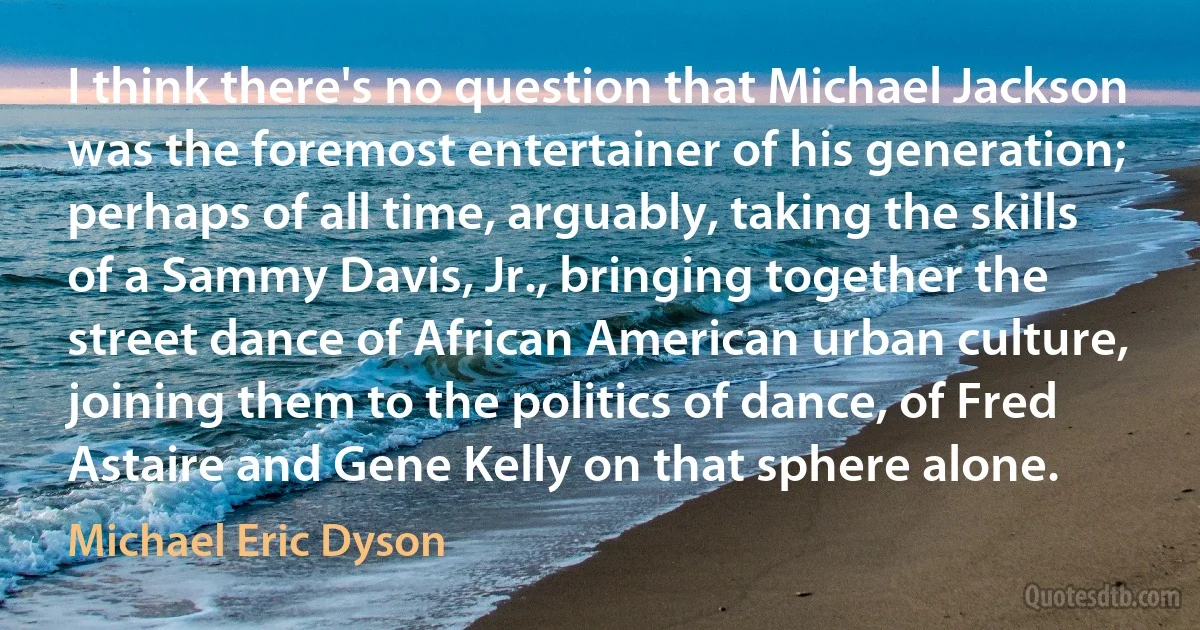Kelly Quotes - page 3
Fred taught me a step because I said I can't let this experience be over without my learning something. He taught me the most wonderful Fred Astaire-like step, with an umbrella. It was a complete throwaway; it was almost invisible. It was in the way he walked. As he moved along, he bounced the umbrella on the floor to the beat and then he grabbed it. It was effortless and invisible. As a matter of fact, a few years later I was photographing Gene Kelly and told him that Fred Astaire had taught me this trick with an umbrella. And Kelly said, "Oh I'll teach you one," and he did, and the two tricks with the umbrella in some way define the difference between Fred Astaire and Gene Kelly, and, in my view, demonstrate who is the greater of the two artists. With Gene Kelly, he threw the umbrella way up into the air, and then he moved to catch it, very slowly, grabbing it behind his back. It was a big, grandstand play, about nothing.

Fred Astaire
The major difference between Astaire and Kelly is a difference, not of talent or technique, but of levels of sophistication. On the face of it, Kelly looks the more sophisticated. Where Kelly has ideas, Astaire has dance steps. Where Kelly has smartly tailored, dramatically apt Comden and Green scripts, Astaire in the Thirties made do with formulas derived from nineteenth-century French Farce. But the Kelly film is no longer a dance film. It's a story film with dances, as distinguished from a dance film with a story. When Fred and Ginger go into their dance, you see it as a distinct formal entity, even if it's been elaborately built up to in the script. In a Kelly film, the plot action and the musical set pieces preserve a smooth community of high spirits, so that the pressure in a dance number will often seem too low, the dance itself plebeian or folksy in order to "match up" with the rest of the picture.

Fred Astaire
I tap danced for ten years before I began to understand people don't make musicals anymore. All I wanted to do was be at MGM working for Arthur Freed or Gene Kelly or Vincent Minelli. Historical and geographical constraints made this impossible. Slowly but surely the pen became mightier than the double pick-up time step with shuffle.

Zadie Smith
McGraw was an improviser, a teacher. He brought much to the game that keeps baseball fresh and suspenseful today-the hit-and-run play, the steal, the squeeze play, the uses of the bunt and the defenses against it. He helped turn the game into a thing of fluid beauty, infielders charging the plate or roaming far from their bases, outfielders moving with each pitch, racing in for base hits before them, backing each other in the outfield, entering the infield itself on rundown plays. Yet when the game changed radically, with the introduction of the livelier baseball, McGraw naturally shifted to a power emphasis, founding his team about such men as George Kelly, Bill Terry, Mel Ott. He knew, too, that the old pitching style of permitting a man to hit a deadened ball because it would then be caught in the big fields had to be changed, and his staffs led the league year after year in strikeouts, in earned-runs.

Arnold Hano
For a long time, the movie [Shrek] didn't know what it wanted to be. One problem was unavoidable: Chris Farley had died, and the story had been geared around him, so when he went, the story kind of went with him. It went through an upheaval while they tried to find the right tone for it. I think they were really close to shelving the project when a few of us came into story to try and find a tone that we could work with. When Kelly Asbury moved on to Spirit: Stallion of the Cimarron I became head of story, along with Randy Cartwright. Along with Andrew Adamson, who stayed on as director, we started pulling little pieces together out of what remained, and part of the way through, Jeffrey [Katzenberg] decided that I should be directing. A few months later, we started production.

Vicky Jenson
Abby Kelly once entered a church only to find herself the subject of the sermon, which was preached from the text: " This Jezebel is come among us also." They jeered at her as she went along the street. They threw stones at her. They pelted her with bad eggs as she stood on the platform. Some of the advocates of the very cause for which she endured all this were ready to drive her from the field.

Lucy Stone
Fox News' Megyn Kelly has fast succumbed to the female instinct to show-off, bare skin, flirt and wink. She now also regularly motormouths it over the occasional smart guest she entertains (correction: the one smart guest, Ann Coulter). At the same time, Kelly has dignified the tinnitus named Dana Perino with a daily slot as Delphic-oracle.

Ilana Mercer
Oleg Cassini is the rarest of rare species: a man who genuinely loves women. And for all his talk it is he that has served them for most of his years. He has devoted his life to making women look and feel beautiful with his classically designed clothes most famously creating 'The Look' for Jacqueline Kennedy when she was First Lady. As the first designer to license in 1951, he has been creating everything from evening dresses to sunglasses in more than 60 countries ever since. His name has always suggested glamour, champagne, polo ponies, a box at the opera, he was married to a movie star, and engaged to Grace Kelly before she became a princess. The son of Russian aristocrats banished to Europe after the revolution...he designs clothes that betray a lifelong ache for lost grandeur, there is about him in every gesture from knocking ash from his cigar to straightening his tie an echo of old world distinction.

Oleg Cassini

![[To Kelly, after he's become suspicious] You haven't been playing doctors and nurses have you? (Ozzy Osbourne)](https://cdn.quotesdtb.com/img/quotes_images_webp/87/ozzy-osbourne-playing-kelly-755987.webp)

